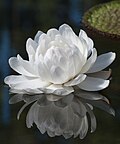Classification System: APG IV
Superregnum: Eukaryota
Regnum: Plantae
Cladus: Angiosperms
Classis: Unassigned
Ordo: Nymphaeales
Familia: Nymphaeaceae
Genus: Victoria
Species (2): V. amazonica – V. cruziana
Name
Victoria Lindl., Monog. 3. 1837.
References
Vernacular names
беларуская: Вікторыя
English: giant water lily
suomi: Jättilumpeet
magyar: Óriás-tündérrózsa
svenska: Jättenäckrossläktet
Victoria is a genus of water-lilies, in the plant family Nymphaeaceae, with very large green leaves that lie flat on the water's surface. Victoria amazonica has a leaf that is up to 3 metres (9.8 ft) in diameter, on a stalk up to 8 metres (26 ft) in length. The genus name was given in honour of Queen Victoria of the United Kingdom.
Extant species
| Image | Scientific name | Distribution | Description |
|---|---|---|---|
 |
Victoria amazonica | shallow waters of the Amazon River basin, such as oxbow lakes and bayous | It is depicted in the Guyanese coat of arms. The flowers are white the first night they are open and become pink the second night. They are up to 40 cm in diameter, and are pollinated by scarab beetles. |
 |
Victoria cruziana | Parana-Paraguay basin | Slightly smaller than V. amazonica, with the underside of the leaves purple rather than the red of V. amazonica, and covered with a peachlike fuzz lacking in V. amazonica. V. cruziana opens its flowers at dusk. |
The first published description of the genus was by John Lindley in 1837, based on specimens returned from British Guiana by Robert Schomburgk. Lindley named the genus after the new Queen, Victoria, and the species Victoria regia. An earlier account of the species, Euryale amazonica Poeppig, in 1832 described an affinity with Euryale ferox. A collection and description was also made by the French botanist Aimé Bonpland in 1825.[1][2]
The leaf of Victoria is able to support quite a large weight due to the plant's structure, although the leaf itself is quite delicate: so much so that "a straw held 6 inches above and dropped perpendicularly upon it would readily pass through it".[3] To counter the fragile nature of the leaf, the weight needs to be distributed across the surface through mechanical means, such as a sheet of plywood. This allows the leaf to support up to 32 kilograms (71 lb).[3]
A woman standing on a leaf of Victoria cruziana in the lily pond in front of the Linnaean House of the Missouri Botanical Garden. A wooden plank and a towel is placed on the pad to prevent damage to the plant.
References
"Nymphaeaceae Victoria Lindl". Plant Name Details. International Plant Name Index. 2005. Retrieved 2009-04-04.
Knotts, Kit. "Victoria's History". Victoria Adventure. Knotts. Retrieved 2012-11-14.
Ripley, George; Dana, Charles Anderson (1861). "Leaf". The New American cyclopaedia: a popular dictionary of general knowledge. 10. New York: Appleton. p. 992.
Giant waterlily at the Royal Botanic Gardens, Kew
Retrieved from "http://en.wikipedia.org/"
All text is available under the terms of the GNU Free Documentation License

